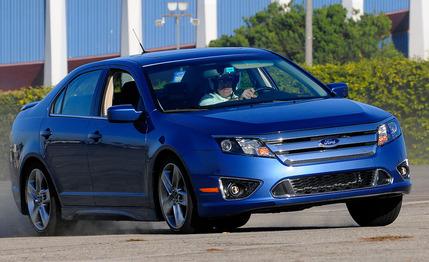 First Drive Review
First Drive Review
Much ado has been made recently about the solvency of Detroit’s Big Three, and if there’s one thing we all know, it’s that none of them will be able to make it out of this financial mess without good products. That makes the arrival of the significantly upgraded 2010 Ford Fusion particularly timely. As the bread-butterer of the Ford car lineup, the Fusion has done reasonably well from a sales standpoint, but based as it is on a platform that debuted way back in 2002 with the Mazda 6, it has fallen considerably behind the rest of the class, finishing sixth out of seven in a recent comparison test of family sedans.
While this latest 2010 Fusion isn’t totally new, it is vastly updated inside, outside, and under the skin. The new Fusion Sport model marks the first Fusion application of Ford’s ubiquitous 3.5-liter V-6, positioned above the four-cylinder and 3.0-liter V-6 offerings, both of which are themselves significantly enhanced for 2010. (A Fusion hybrid model is also available for the first time, and we’ve found it to be shockingly good.) Given the thorough revisions, we were anxious to get into the 2010 Fusion to see if its dynamics could match its considerably improved interior and exterior styling.
Bold and Macho on the Outside
On the road, the Fusion looks entirely dressier and far more noticeable to the casual observer (and likely, the cops), as this update represents more than a refresh and is closer to a redesign. The redo starts with a newly styled fascia and hood that incorporate some of the cues of Ford’s European lineup, such as a lower-intake shape similar to that of the slick Mondeo and the soon-to-be-Americanized Fiesta. Above that, however, lives pure American Ford, with a huge three-bar grille, brooding headlamps, and a tall, domed hood. Ford claims that aerodynamics are considerably improved compared with the first generation. The base model rides on 16-inch wheels and Sport models wear 10-spoke 18-inch wheels, while everything else get 17s standard and have 18s as an option. In back, the beveled taillamps, skirted bumper valance, and contoured decklid add substance and intrigue to what was a painfully dull posterior before, excepting, of course, the vulgar chunks of chrome that housed the taillights.
Soft and Cuddly on the Inside
While the interior is also hugely improved, it breaks little new ground in terms of design or material application. Most improvements focus on climbing the scale of perceived quality, with liberal use of soft materials at touch points all around and low-gloss plastics (except for the piano-black gearshift surround on the Fusion Sport). The electroluminescent instrument cluster is arguably its nicest element: clear, legible, and distinctly upscale with red needles climbing over white script on a conelike, blue and black 3-D background. The thick center stack could be from any mid-size sedan, and regardless of whether or not the Fusion is equipped with the available SYNC infotainment system, it suffers from a serious case of button-itis.
The Fusion does dip into Ford’s more recent bag of tricks for its customizable ambient/cupholder lighting system that some of us love and some of us dismiss as mere auto fluff. What’s not auto fluff is Ford’s latest-gen SYNC infotainment system, which includes things like fuel-price search capability and real-time traffic, all of which has earned praise on our pages before.
The only thing we find truly controversial is the contrasting interior color combos on the Fusion Sport models, which feature bright blue or red leather inserts on the seats and matching rubber-like trim on the dash. The good news is that when you actually sit inside, you can’t see the bright leather, leaving only the dash trim to be savored in all its glory. You can also opt for an all-black interior, which would be our choice.
Capable Four-Cylinder, Best Application Yet of 3.5-liter V-6
The Fusion’s powertrain lineup has been completely overhauled for 2010 and offers more choices, starting with the four-banger, now enlarged to 2.5 liters from 2.3 and blessed with 15 more hp and 16 additional lb-ft of torque for a total of 175 hp and 172 lb-ft. The manual and automatic transmissions that mate to the four-cylinder each have an additional forward gear this year, too, for a total of six. In spite of its frugal intentions—Ford claims 33 mpg on the highway, but had no figures for city-cycle mpg at the time of this writing—we found the motor to be willing, revvy, and smooth. Ultimate acceleration is on the lazy side of adequate, but the midrange punch is quite satisfying. Ford claims a 0–60 time of 9.5 seconds, but that was the pokey time we recorded in a 2.3-liter car with a five-speed automatic. Additionally, a 2.3-liter Fusion with a five-speed manual was clocked at 8.1 seconds to 60, so we expect the 2010 model to handily outpace Ford’s estimates.